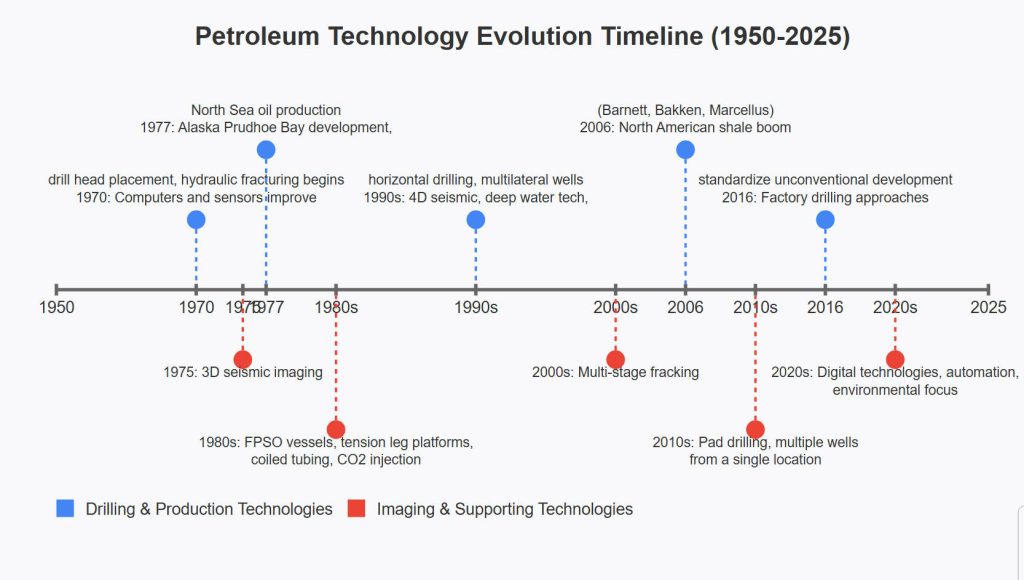
An overview of reserves and extraction for each period:
- Pre-1970s Conventional Field Oil:
- Original estimated reserves: ~150-200 billion barrels
- Extracted through 2023: ~150 billion barrels
- Remaining reserves: ~20-30 billion barrels (primarily in mature fields with enhanced recovery)
- Notable: Most major conventional fields are in decline, with recovery rates improved from ~25% to 35-40% through enhanced oil recovery techniques
- Alaska’s Prudhoe Bay (1977 onward):
- Original estimated reserves: ~25 billion barrels
- Extracted through 2023: ~13 billion barrels
- Remaining reserves: ~5-6 billion barrels
- Notable: Production peaked at 2 million barrels/day in 1988, now around 400,000 barrels/day
- Offshore Development (Gulf of Mexico):
- Original estimated reserves: ~45-50 billion barrels
- Extracted through 2023: ~22 billion barrels
- Remaining reserves: ~15-20 billion barrels
- Notable: Deep water Gulf of Mexico still holds significant potential
- Unconventional/Fracking Revolution:
- Original estimated technically recoverable reserves: ~100 billion barrels oil, ~700 trillion cubic feet gas
- Extracted through 2023: ~25 billion barrels oil, ~200 trillion cubic feet gas
- Remaining reserves: Highly variable based on price assumptions and technology improvements
- Notable: Permian Basin alone estimated to contain 50+ billion barrels of recoverable oil
- LNG Revolution:
- Based on natural gas reserves noted above
- U.S. export capacity (2023): ~14 billion cubic feet per day
- Projected capacity by 2025: ~20 billion cubic feet per day
- Total exported since major terminals opened: ~30 trillion cubic feet
- Notable: U.S. has potential to remain a major LNG exporter for decades with current reserve estimates
U.S. Petroleum Production by Extraction Type (1950-2024)
Peak and Current Production
| Type | Peak Production | Peak Year | Current (2024) | % of Current Total |
|---|---|---|---|---|
| Conventional | 9.0 mbpd | 1970 | 2.0 mbpd | 14.7% |
| Alaska Prudhoe Bay | 2.0 mbpd | 1989 | 0.6 mbpd | 4.4% |
| Offshore | 2.0 mbpd | 2022 | 2.0 mbpd | 14.7% |
| Fracking/Shale | 9.0 mbpd | 2024 | 9.0 mbpd | 66.2% |
| TOTAL OIL | – | – | 13.6 mbpd | 100% |
| LNG Exports | 14.0 bcf/d | 2024 | 14.0 bcf/d | 14.0% of production |
| Total Gas Production | 99.9 bcf/d | 2024 | 99.9 bcf/d | 100% |
Estimated Cumulative Production (1950-2024)
| Type | Cumulative Production |
|---|---|
| Conventional | 148.0 billion barrels |
| Alaska Prudhoe Bay | 21.2 billion barrels |
| Offshore | 24.5 billion barrels |
| Fracking/Shale | 32.4 billion barrels |
| Total Oil | 226.0 billion barrels |
| LNG Exports | 23.0 trillion cubic feet |
Production Characteristics by Type
1. Conventional Field Oil
- Dominated U.S. production until the 1980s
- Peaked in 1970 at 9.0 million barrels per day
- Steady decline since peak, with enhanced recovery techniques slowing the decline rate
- Mature fields with relatively high operating costs but low capital requirements
2. Alaska’s Prudhoe Bay
- Rapid development after 1977 discovery
- Peak production in 1989 at 2.0 million barrels per day
- Significant decline to current 0.6 million barrels per day
- Infrastructure challenges with aging Trans-Alaska Pipeline
3. Offshore Development
- Gradual growth from shallow to deep water
- Current production near all-time high at 2.0 million barrels per day
- High capital costs but relatively stable long-term production
- Concentrated in Gulf of Mexico with potential for expansion
4. Unconventional/Fracking
- Explosive growth since 2006
- Currently at peak production of 9.0 million barrels per day
- Dominates current U.S. production at 66.2%
- Characterized by high initial production and rapid decline rates requiring continuous drilling
5. LNG Exports
- Rapid export terminal development since 2016
- Currently at 14.0 billion cubic feet per day export capacity
- Represents conversion of ~14% of U.S. gas production to export
- Additional export capacity under development
Note: These are approximate estimates based on historical trends and simplified models.
mbpd = million barrels per day bcf/d = billion cubic feet per da